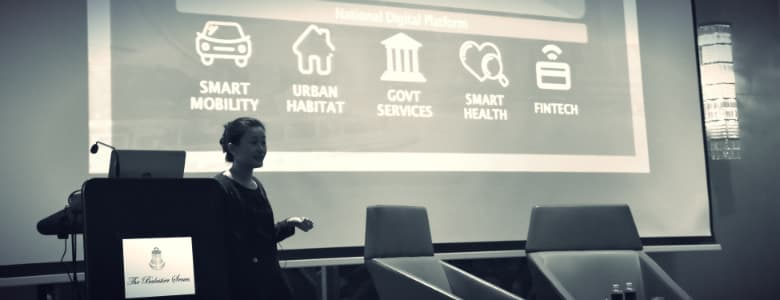Smart way to build a Smart Nation

What defines a smart city?
Turns out, there are no hard and fast rules of definition.
As cities around the world turn to technology to improve services for their citizens, no two develop along exactly the same lines. In some, environmental sustainability and open data are top priorities; in others, a comprehensive e-payment system or fast, widespread connectivity may be what people value most.
“In Singapore, were we really expected to put all these together, and take a ‘pau ka liau’ [a comprehensive colloquial term for ‘all-inclusive’] approach to technology and smart cities?” asked Government Technology Agency of Singapore (GovTech) Chief Executive Ms Jacqueline Poh.
Ms Poh was addressing members of the American Chamber of Commerce in Singapore (AmCham) at the organisation’s Balestier Series, held on 31 May 2017. First launched in 2014, the Balestier Series features talks from eminent Singaporeans on significant issues.
Ms Poh’s answer to her own question? In a word, no.
“It’s easy to think that the only way to satisfy all the stakeholders is to toss in a little bit of everything into the mix,” she said.
“But maybe that’s not quite us. We should take what is relevant to us and ditch what is not.”
Different roads to Smart Nation?
One area that Singapore’s Smart Nation initiative has chosen to focus on is intelligent transportation, said Ms Poh.
To tackle congestion, the government is looking to build a multimodal transport system, with the use of autonomous vehicles or pods to help people travel the last mile to their destinations.
About 12 percent of Singapore’s land is currently covered by roads — a relatively high figure compared to the US, added Ms Poh.
But with an intelligent transport system, Singapore’s landscape could look very different in the future.
“Singapore should be a city designed for its denizens, and not necessarily for cars,” remarked Ms Poh. “A lot of the logistics, train transportation and autonomous transportation pods could be moved underground.”
In addition to congestion, Singapore also needs to develop innovative methods of coping with the healthcare needs of an ageing population. One priority is to find ways to allow the elderly to age gracefully at home rather than in a hospital, said Ms Poh.
This will involve the implementation of telehealth initiatives such as video consultations, tele-rehabilitation and vital sign monitoring at home, she shared.
“All of this is coming so that people on this island need not visit a hospital.”
Pushing boundaries through collaboration
In addition to focusing on areas such as transport and healthcare, there is also a need to develop integrated nation-wide digital platforms, said Ms Poh.
For example, the government is planning to build a Smart Nation Sensor Platform, which will collect, integrate and analyse data from sensors across the country, she said.
Insights from this data could serve a variety of purposes in the areas of security, transport or environmental protection, for instance.
In all of this, Ms Poh sees plenty of opportunities for innovation to come from industry.
“We do want to push the boundaries together with the private sector, and we’ve been looking at different ways in which we can bring in research partners, startups and industry users to pilot solutions with us,” she said.
“We’re looking forward to working with you not only on these major platforms, but also on other innovations or research pieces that make up the Smart Nation.”
Everyone get involved!
The session also featured a question and answer segment moderated by Mr Steve Leonard, Chief Executive Officer of SGInnovate.
Noting that cash and cheque payments are still prevalent in Singapore, a member of the audience commented that even if more digital services are rolled out, traditionalists would not adopt them unless effective incentives — or disincentives against paper-based methods — are implemented.
Agreeing, Ms Poh said that the adoption of digital payment methods has been slow in safe societies like Singapore and Japan, because carrying and storing cash does not pose much of a hazard.
More needs to be done, she added, to figure out how best to convince people to go digital.
One way might be to make the case that digital systems will make things cheaper for the consumer in the long run — parking rates, for example, might go down with a more cost-effective digital coupon system, said Ms Poh, who also encouraged the audience to come forward with their own ideas.
“We’re going to weave our way forward, and it would really help our case if more of you could write to our political office holders or to the forum pages of the newspapers about how things could be done,” she said.
Mr Leonard, wrapping up the session, also urged the audience to get involved. “If there’s something you’d like to make better, give feedback.”
He added: “But more importantly, don’t preach from the sidelines — a great way to get involved in Smart Nation is to adopt, use, evangelise and tell other people about what’s possible.”
https://www.tech.gov.sg/media/technews/smart-way-to-build-a-smart-nation
